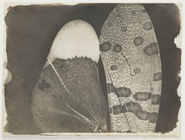
William Henry Fox Talbot, Photomicrograph of moth wings, ca. 1840; Calotype negative
From October 11, 2008, through January 4, 2009, the San Francisco Museum of Modern Art (SFMOMA) presents Brought to Light: Photography and the Invisible, 1840–1900. The exhibition explores the use of photography in 19th-century science, with a particular focus on the representation of phenomena invisible to the naked eye.
Organized by SFMOMA Associate Curator of Photography Corey Keller, Brought to Light features more than 200 vintage photographs and rare photographically illustrated books, most of which have never been on public display in the United States. The exhibition includes works made between 1839 and 1900 by both noted scientists and amateur experimenters. Drawn from American and European private and public collections, highlights include some of the earliest daguerreotypes made through the microscope; Jules Janssen’s circular daguerreotype plate of the 1874 transit of Venus; photomicrographs by William Henry Fox Talbot and Auguste-Adolphe Bertsch; motion studies by Eadweard Muybridge and Étienne-Jules Marey; and early X-ray photographs by Josef Maria Eder and Eduard Valenta; and spirit photographs by Louis Darget.
According to Keller, “The fact that these extraordinary photographs continue to surprise and amaze us is, I think, a testament both to an incredibly exciting scientific moment and to the enduring power of photography. Though we now possess much more sophisticated technologies for scientific imaging, it is still easy to see why these pictures would have been so impressive – both to scientists and the general public — when they were first made. This exhibition is a tremendously exciting opportunity to bring together these rare and important works, and we are thrilled to be able to share them with our visitors.”
Modern science and photography flowered simultaneously in the early 19th century and photography was adopted as a scientific tool from the moment of its invention in 1839. Over the course of the century, scientists made pictures using the microscope, the telescope, and the X-ray, capturing previously hidden realms both infinitesimally small and unimaginably large. They used photography to analyze motion, to see into faraway galaxies, and to look inside the human body. Brought to Light includes examples of early scientific (and pseudoscientific) photography and considers what it meant at that time to “see” photographically. Equally importantly, the exhibition invites viewers to imagine what pictures of the invisible might have meant at a time when the worlds revealed by contemporary technologies such as satellite imaging and PET scans were utterly unimaginable. Despite our increasingly sophisticated technology, these early scientific works continue to exert a powerful hold on the imagination. In the 20th century, artists as diverse as Francis Picabia, László Moholy-Nagy, John Heartfield, Vija Celmins, and Thomas Struth have drawn inspiration from the radical visual models these scientific photographs introduced.
For much of the nineteenth century, one of the most potent analogies for making sense of the photographic medium compared the camera to the eye, and the act of photographing to that of sight. Photography’s relationship to vision, as well as to scientific knowledge, became more complicated, however, when the subject to be photographed was invisible. It is commonplace to say that photography changed the way we see the world. In the 19th century, however, and particularly in the realm of science, this was literally true. Furthermore, the proliferation of photography helped encourage an entire new genre of literature and journalism: popular science. The dramatic pictures made by these early photographers opened up the spectacle of the natural world not only to the scientific community but also to the awestruck public.
The exhibition is accompanied by a hardcover publication, Brought to Light: Photography and the Invisible, 1840–1900, with essays by Corey Keller, Tom Gunning, Jennifer Tucker, and Maren Gröning. The finely reproduced plates are divided into six basic categories, such as the microscope and the telescope, each accompanied by a text introducing important innovators of the time and the processes they used to make their pictures.
In addition, throughout the run of the exhibition, The Pencil of Nature, a film produced for the Humanities and Sciences in 1989, will be shown daily in the SFMOMA Koret Visitor Education Center at 1, 3, and 4:30 p.m. The 26-minute film is free with admission.
The exhibition is organized by SFMOMA and is generously supported by the George Frederick Jewett Foundation. Following its San Francisco presentation, Brought to Light will travel to the Albertina in Vienna where it will be on view from March 20 – June 6, 2009.
For additional information, please visit www.sfmoma.org.